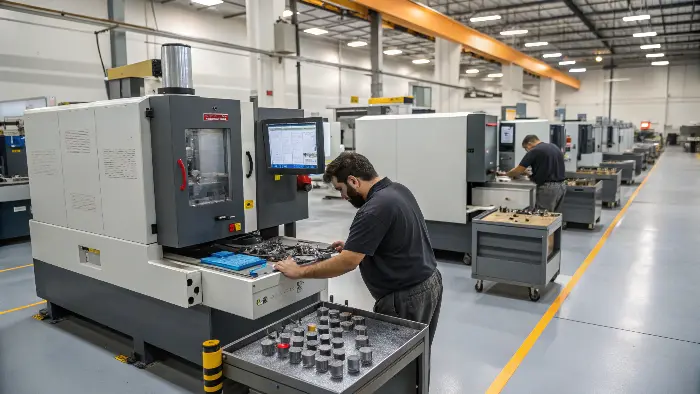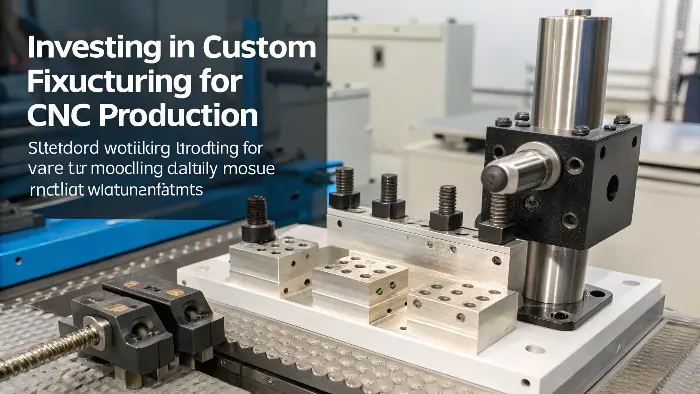Struggling with part movement or long setup times in CNC? These issues kill precision and profit. Discover advanced workholding for superior results and efficiency.
Beyond basic clamps, advanced CNC workholding involves specialized vises, vacuum chucks, magnetic tables, zero-point systems, and custom fixtures. These secure complex or delicate parts, improve accuracy, reduce setup times, and enable multi-axis machining effectively.
I’ve seen firsthand how the right workholding transforms a CNC operation from a struggle to a smooth, precise process. Basic clamps and vises are fine for simple jobs. But when you’re dealing with tight tolerances, complex shapes, or high-volume production like Alex often does for his robotic components, you need to think beyond the basics. Let’s explore why upgrading your workholding strategy is so important and what options are available.
Why is Advanced Workholding Crucial for Precision and Efficiency in CNC Machining?
Insecure parts cause defects, tool breakage, and lost time. This frustration eats into your CNC shop’s productivity and reputation. Advanced workholding is the key.
Advanced workholding is crucial because it ensures rigid part holding for tighter tolerances, reduces vibration for better surface finish, minimizes setup times for increased throughput, and allows access to multiple part faces, significantly boosting overall CNC precision and operational efficiency.
The foundation of any successful CNC machining job is how well the workpiece is held. If the part moves even slightly during cutting, you lose accuracy. This can lead to scrapped parts, which is a direct hit to your bottom line. I remember a case with a client, similar to Alex, who was struggling with achieving consistent ±0.01mm tolerances on some aluminum housings. Their basic toe clamps just weren’t providing enough consistent rigidity. Advanced workholding provides superior clamping force and stability. This minimizes vibrations, which not only improves dimensional accuracy but also leads to better surface finishes and longer tool life. Furthermore, many advanced systems are designed for quick changeovers. This drastically reduces machine downtime between jobs, making your operations much more efficient. For example, when machining multiple sides of a complex part, advanced workholding can provide better access and reduce the number of setups needed. This directly translates to faster cycle times and higher productivity.
What Specialized Workholding Solutions Tackle Complex Geometries and Delicate Parts?
Oddly shaped or fragile parts are a nightmare to clamp securely. This risk of damage or poor machining can stop projects. Specialized solutions exist.
Specialized solutions like vacuum chucks, magnetic workholding, and soft jaws excel with complex or delicate parts. Vacuum chucks secure thin or non-magnetic items without distortion, while magnetic chucks offer quick clamping for ferrous materials.

When standard vises and clamps won’t cut it, specialized workholding shines. I’ve seen these solutions save the day many times. Let’s look at a few key types:
Vacuum Workholding
Vacuum chucks are fantastic for holding thin, flat, or non-magnetic materials that are difficult to clamp mechanically without distortion. Think of machining large sheets of aluminum or plastic, or even delicate engraving work. The workpiece is held by atmospheric pressure against a sealed surface with vacuum drawn underneath. This provides even clamping force across a large area. I recall a project involving thin polycarbonate covers for a robotics application; mechanical clamps were causing bowing, but vacuum chucks held them perfectly flat, ensuring the precision Alex needed.
Magnetic Workholding
For ferrous materials (those containing iron, like steel), magnetic chucks offer incredibly fast and strong clamping. They use powerful permanent magnets or electromagnets. You simply place the workpiece on the chuck and activate the magnet. This allows for full access to five sides of the part in many cases, as there are no clamps in the way. This is great for grinding, milling, and even EDM. We’ve used them at QuickCNCs for batches of steel components for industrial machinery, significantly speeding up setup between operations and improving throughput.
Soft Jaws and Custom Nests
For parts with irregular shapes, soft jaws (machinable vise jaws) can be custom-milled to perfectly match the part’s contour. This provides excellent support and prevents marring delicate surfaces. Similarly, custom nests or fixtures can be 3D printed or machined to hold uniquely shaped components securely. These are often used for high-volume production of a specific part or for prototyping complex forms where standard clamping is impossible. I’ve seen this approach dramatically improve consistency for awkwardly shaped cast parts.
How Do Modular Fixturing and Zero-Point Systems Boost CNC Productivity?
Lengthy CNC setup times steal valuable machine hours. This inefficiency limits output and inflates costs. Modular and zero-point systems offer a rapid solution.
Modular fixturing and zero-point clamping systems dramatically boost CNC productivity by enabling rapid, repeatable, and precise setups. They reduce machine downtime between jobs, allowing for quicker changeovers and increased overall equipment effectiveness (OEE).

Boosting productivity is a constant goal in any CNC shop. Two powerful workholding strategies for this are modular fixturing and zero-point clamping systems. I’ve implemented these with clients and seen remarkable improvements in their machine utilization.
Modular Fixturing Explained
Modular fixturing uses a system of standardized base plates, risers, clamps, and locating elements. Think of it like an industrial-strength LEGO set for workholding. You can quickly assemble a fixture for a specific part, and then easily reconfigure it for the next job. This flexibility is a huge advantage over dedicated, single-purpose fixtures, especially for shops with a high mix of parts, like those doing frequent prototype revisions similar to Alex’s work. It reduces the need to design and store numerous custom fixtures. I’ve seen shops reduce setup times from hours to just minutes by adopting a good modular system for their various projects.
The Power of Zero-Point Clamping
| Zero-point clamping systems take this a step further. They establish a precise and repeatable reference point on the machine table. Fixtures or vises equipped with corresponding clamping pins can then be loaded and locked into place in seconds, with micron-level repeatability. This means you can set up a job offline on a separate fixture plate while the machine is running another part. When it’s time to change over, you simply swap the fixtures. The machine knows exactly where the new part is located because the zero point is pre-established. This almost eliminates on-machine setup time, maximizing spindle uptime. This is incredibly valuable for engineers like Alex who need to manage multiple prototype revisions quickly. Table: Benefits of Modular vs. Zero-Point Systems |
Feature | Modular Fixturing | Zero-Point Clamping |
|---|---|---|---|
| Primary Goal | Versatility, reconfigurability | Speed, repeatability, offline setup | |
| Setup Time | Reduced (assembly required on/off machine) | Drastically reduced (quick swap on machine) | |
| Repeatability | Good | Excellent (micron-level) | |
| Investment | Moderate | Higher initial, fast ROI | |
| Best For | High-mix, low-to-medium volume; job shops | High-volume, or frequent/fast changeovers |
When Does Investing in Custom Fixturing Make Sense for CNC Production?
Standard workholding struggles with very complex or high-volume parts. This can lead to inconsistencies, slow cycles, or even part damage. Custom fixtures provide stability.
Investing in custom fixturing makes sense for high-volume production runs of specific parts, parts with extremely complex geometries, or when maximum rigidity and repeatability are absolutely critical to meet tight tolerances and demanding quality standards.

While modular systems offer flexibility, there are situations where a fully custom fixture is the best investment. I generally advise clients to consider custom fixturing when certain conditions are met, often balancing upfront cost with long-term gains.
High-Volume Production
If you’re machining hundreds or thousands of the same part, the upfront cost of designing and building a custom fixture can be easily justified. A dedicated fixture can be optimized for the fastest possible loading and unloading, and for holding multiple parts simultaneously if the machine and part size allow. This dramatically reduces cycle time per part and operator intervention. I worked with a company producing a specific automotive component in large quantities. A custom hydraulic fixture we designed at QuickCNCs reduced their per-part machining time by over 30% and improved consistency.
Extremely Complex Geometries or Delicate Features
Some parts have shapes that are just too awkward or difficult to hold securely and accurately with standard or even modular workholding. This is particularly true for parts with many intricate features or those made from delicate materials that could be easily damaged by conventional clamping. For these, a custom fixture, perhaps incorporating features like custom-molded nests, vacuum ports, or precisely located clamping points, is essential. This ensures the part is held rigidly in the correct orientation for all machining operations, preventing errors, reducing scrap, and improving overall quality. Alex’s robotic arm components often have such complexities, where a custom solution ensures every tolerance is met.
When Ultimate Precision and Repeatability are Non-Negotiable
For applications demanding the absolute highest levels of precision (e.g., ±0.005mm) and repeatability, a custom fixture designed specifically for that part can minimize all potential sources of error. It can be built to be extremely rigid, thermally stable, and to locate the part with unparalleled accuracy. This is often the case in aerospace, medical device manufacturing, or high-precision optics. While the initial cost is higher, the cost of scrap, rework, or failure in these critical industries is even higher, making custom fixtures a wise and necessary investment for quality assurance.
Conclusion
Beyond basic clamps, advanced CNC workholding like specialized vises, vacuum, magnetic, zero-point systems, and custom fixtures significantly boosts precision, efficiency, and capability for complex machining tasks.


